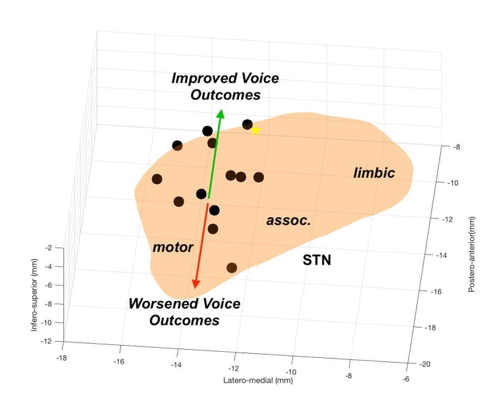Session Information
Date: Wednesday, September 25, 2019
Session Title: Surgical Therapy
Session Time: 1:15pm-2:45pm
Location: Les Muses Terrace, Level 3
Objective: Determine the relationship of active contact location to postoperative changes in cepstral analyses of voice, following subthalamic nucleus (STN) deep brain stimulation (DBS) for Parkinson’s disease (PD).
Background: As PD progresses, many patients suffer an increasingly significant decrease in their ability to communicate through speech. Indeed, voice and speech deficits impact a patient’s identity and social functioning. Despite the therapeutic efficacy of DBS related to motor symptoms in PD, there is no consensus regarding the effect of lead location on voice-related outcomes, as DBS has been reported to both improve and worsen various aspects of voice and speech function.
Method: Speech pathology evaluations were obtained from 14 PD subjects, before and after STN-DBS. Measures included audio-perceptual voice ratings (overall severity, loudness, hoarseness changes), indices of dysphonia (cepstral peak prominence and cepstral spectral index of dysphonia), and phonatory aerodynamics. The contacts used for active stimulation at the time of the postoperative speech pathology evaluation were determined and assessed in relation to changes in voice measures.
Results: Voice function following DBS remained relatively unchanged, averaged across the cohort. However, stimulation locations in the anterior portion of the sensorimotor region of the left STN were associated with improvements in voice severity scores, cepstral spectral index of dysphonia (CSID), shortness of breath, and phonatory airflow during connected speech [figure1]. Posterior locations were associated with worsening of these outcomes. Variation in the medial-lateral or dorsal-ventral location on the left, and in any direction on the right, did not correlate with any outcome measure.
Conclusion: Active contact placement within the left anterior sensorimotor STN was associated with improved subjective and objective voice-related outcomes. These findings suggest a topography for voice-related STN function.
To cite this abstract in AMA style:
A. Jorge, C. Dastolfo-Hromack, W. Lipski, I. Kratter, L. Smith, J. Gartner-Schmidt, R. Richardson. Stimulation of the Left Anterior Sensorimotor Subthalamic Nucleus Improves Voice Function in Parkinson’s Disease [abstract]. Mov Disord. 2019; 34 (suppl 2). https://www.mdsabstracts.org/abstract/stimulation-of-the-left-anterior-sensorimotor-subthalamic-nucleus-improves-voice-function-in-parkinsons-disease/. Accessed December 19, 2025.« Back to 2019 International Congress
MDS Abstracts - https://www.mdsabstracts.org/abstract/stimulation-of-the-left-anterior-sensorimotor-subthalamic-nucleus-improves-voice-function-in-parkinsons-disease/

